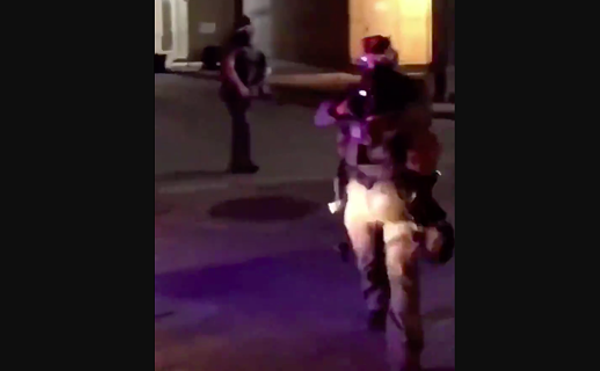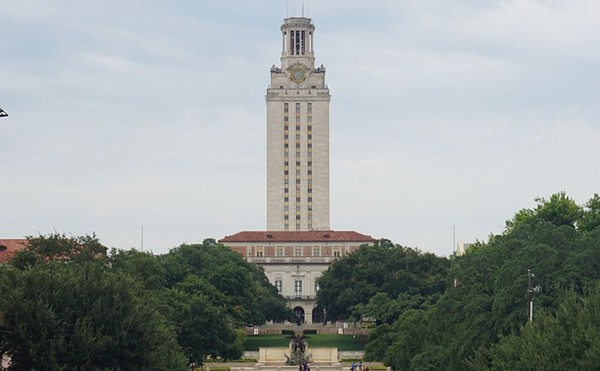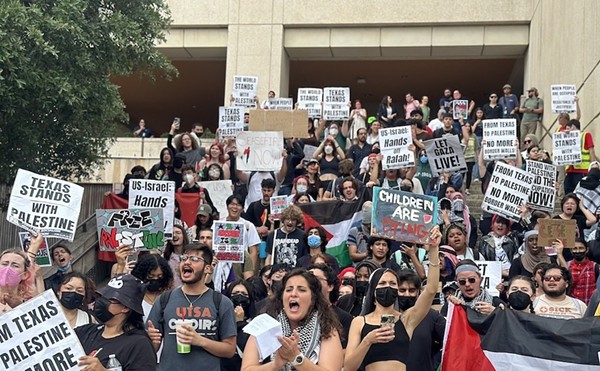By Enrique Lopetegui
[email protected]

She broke down in tears and had to be consoled by fellow activists.
The copy of the petition faxed to the QueBlog reads that "the human and civil rights of our families and those who wish to assist us are ... violated." It is signed by 235 names (our count), each with its respective legal resident number and their city of origin.
The activists tried to present the letter to Pitts, but couldn't get past security.
"We were rejected," Grassroots Leadership's Bob Libal told the QueBlog. "They told us to mail it."
According to Amnesty International's "Jailed Without Justice" report, "immigrants and asylum seekers may be detained for months or even years as they go through deportation procedures that will determine whether or not they are eligible to remain in the United States.
"According to a 2003 study, individuals who were eventually granted asylum spent an average of 10 months in detention with the longest reported period being 3.5 years ... Individuals who have been ordered deported may languish in detention indefinitely if their home country is unwilling to accept their return or does not have diplomatic relations with the United States."
Under U.S. law, those in deportation proceedings can secure legal representation but not at the expense of the government. Therefore, according to Amnesty, "84 percent of those in immigration detention do not have a lawyer, and instead represent themselves."
AI's report says that "detainees are often detained in jail facilities with barbed wire and cells, alongside those serving time for criminal convictions. They are not able to wear their own clothes but instead wear prison uniforms. Immigrants are unnecessarily exposed to inappropriate and excessive restraints including handcuffs, belly chains, and leg restraints ... `and` physical and verbal abuse."
"After mentioning that "lawful permanent residents can be placed in 'mandatory detention' with no right to a bond hearing before an immigration judge or judicial body," AI concludes that "conditions of detention in many facilities do not meet either international human rights standards or ICE guidelines."
In September 2008, ICE announced the publication of 41 new performance-based detention standards, but AI was skeptical: "They are not legally enforceable and do not provide adequate sanctions for violations."
Silky Shah, member of board of directors of Grassroots Leadership and Organizing and Outreach Coordinator for Detention Watch Network, agrees.
"`The abuses that are` happening right now," she said, "will outlast any comprehensive reform that `takes place`, and we need to continue working together restoring justice for all."
Sarnata Reynolds, Amnesty International's campaign director for refugee and migrant rights, visited Port Isabel in July 2009 in a rare field visit by a human rights group.
"We were there last June, and besides what we told the media we haven't released an official statement `on PIDC`," Reynolds told the QueBlog on Friday. "I don't want to misspeak. I want to review my notes before I get back to you."
In June 4, 2009, a day after her visit to PIDC, she told the Houston Press that AI's preliminary findings confirmed that detainees are "locked up, and you have no right to a bond hearing. You have no right to ever demonstrate that ... 'I'm not a danger to the community, I'm not a flight risk, so let me out while I proceed `with` my removal proceedings.'"
One of the detainees she spoke to was Rama Carty, a native of Congo who has resided legally in the U.S. since 1971, at age one.
He was detained in Maine in May of 2006 for a drug offense he claims was fabricated. After serving less than two years of prison time, he was held at ICE detention centers in Main, Massachusetts, New Hampshire, Pennsylvania, and Louisiana, before arriving at PIDC in December 2008.
With two other detainees, he organized a hunger strike at PIDC on April 15, 2009, to expose to the media the conditions of detention.
"We got at least 70 other detainees, maybe 90, but it went down quickly after the authorities started applying pressure on us," he told the QueBlog. "Some people did three weeks `of hunger strike`, but they threatened me with cutting me the access to the law library. I needed that, so I stopped."
On June 3, the day he said he was supposed to meet with Reynolds for the second time, at 5 a.m. he was awaken by guards who told him to pack because he was leaving.
"I told them I shouldn't be leaving, since `the Department of Homeland Security` was negotiating with AI to meet with us and I wasn't done with my interviews," Carty said. "I smelled something fishy immediately."
That's when he was attacked, he says, but the guards accused him of assault. On that same day, Carty was transferred to an ICE detention center in Louisiana, but couldn't be deported because no country would recognize him as a citizen.
"I was going to be in limbo until who knows when," Carty said.
In the fall of 2009, Carty successfully sued ICE and obtained a $100,000 unsecured bond that allowed him to walk free in December 2009. After spending time in Massachusetts, he's now back in Texas since February 22, under home arrest at a hotel in Brownsville, awaiting his March trial for the assault
"If I'm a flight risk, why did I come back?" he said. "They offered me `to plead guilty to` a misdemeanor, but I'm not going to do that. I want to go to trial, I didn't do anything."
He also won't go on the record with details of the attack, but wants to set the record straight.
"I don't want to publish specifics that will need to be divulged at trial," he said. "But I do want to let everyone know that I was assaulted, not the other way around. When I could not be deported, I was wrongfully indicted `for supposedly attacking the guards,` in order `for them` to leverage against a possible civil action."
He says he was shaving when the guards jumped on him, and now they're saying that he used a razor to attack them.
"The missing video and the missing razor are two of the most glaring pieces of missing evidence," Carty said. "It's clear in the very little bit of video that the government has produced, which shows my being hit when I was on the floor at the very end of the incident, that the entire video should have been available. The entire video would have made it clear that I should not have been indicted in the first place. But of course, there is no video, because if there is a video, they have no case.
"Everything happens at `PIDC`: Everything from sexual harassment of male and female detainees, assault, pitting black detainees against Hispanics and vice versa, in an attempt to divide and conquer. It's a terrible situation and it has been going on for decades."
"In all my years, I've never seen immigrants raising a hand against guards," said Tony Hefner, a guard at PIDC from 1983 through 1990. "It's always been the other way around."
Hefner, who says he was fired in 1985, got his job back in 1987, and was fired again in 1990, spent years gathering information about abuses at PIDC and will publish his findings, "real names and all," in the book Between the Fences: Before Guantanamo, there was the Port Isabel Service Process Center, due out in May. Some of those names, documents and pictures a la Abu Ghraib can be seen in his website, torchlake.com/hefner.
"The very same thing that happened `in my time` is happening today `at PIDC`," said Hefner. "Stealing money from detainees, beating detainees up ... If detainees from two different countries were fighting, they would handcuff them together and push them into each other and take bets on them."
Hefner will be a witness for Carty during the trial.
"They're framing this young man claiming that he did something that he didn't do," Hefner said. "That's the standard policy there: If you stand up against them, they nail you. What Rama `Carty` is going through is nothing unusual."
Nina Pruneda, spokeswoman for ICE in San Antonio, said the QueBlog's information "is not correct information."
"Torture? That's the first time I ever heard of that," she said Friday. "There are a lot of rumors in the community but, believe you me, there's nothing of that nature going on.
"We need the names of those detainees. For security purposes we don't obtain information like that `letting the activists into the building`, they have to mail it. That's the process."
So if we get you the names ...
"Names, dates of birth, and A `resident` numbers," she said. "And Monday we'll get back to you with the other information you requested."
"The other information we requested included whether ICE's 41 new performance-based detention standards have already been implemented, what happens if a detention guard violates those standards, what is ICE's policy in regards to hunger strikes, whether force-feeding is ever used with hunger strikers, and, finally, what actions - if any - Pitts ordered to be taken against the hunger strikers.
We'll be waiting ...


















